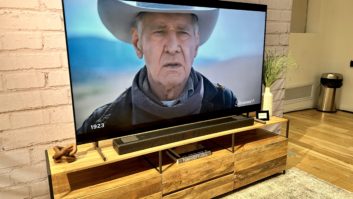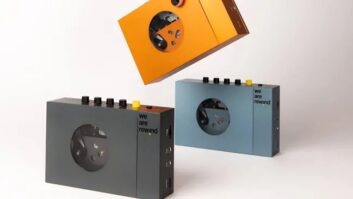NEW YORK – Sony Ericsson Mobile Communications is focusing on entertainment, digital imaging, and productivity applications in launching its first co-branded wireless handsets for the North American market.
The joint-venture company, formed last October, said the products will support carriers’ growing emphasis on retaining subscribers and increasing average revenue per subscriber. The products will also help stimulate replacement sales following a year in which worldwide factory-level handset shipments fell, the company said.
“In more developed markets, carriers are moving away from growing [subscriber] numbers to increasing ARPU (average revenue per unit),” said Sony Ericsson president Katsumi Ihara. “The only way to make that happen is to provide exciting new services.” Consumers who have become more sophisticated and demanding, he added, won’t replace phones unless they’re offered “exciting applications and product features.”
To support these twin goals, the joint-venture company announced a nonexclusive collaboration with Sony’s content companies to offer embedded and downloadable movie- and music-related content and single- and multiplayer games.
Similarly, Sony has already upgraded its Sony Style Imaging web site to support wireless access from Sony Ericsson combination camera-phones. Phone users can wirelessly post digital images from the phone to the web site to share with friends and family. Users can also use the phones to download images from the site’s public-image galleries to use as phone wallpaper or screensavers or to send to others.
In music, Sony will initially offer ring tones based on music from Sony artists, but downloadable music is possible as data speeds grow. Downloadable movie previews and move-scene-based wallpaper and screensavers will be available in the second quarter in the United States in cooperation with U.S. carriers, said Rio Caraeff, wireless services VP at Sony Pictures. Sony is already in trials in Europe to stream video over noncommercial W-CDMA networks, he noted. Availability of Java-based Sony games hasn’t been announced.
Worldwide marketing VP Philip Vanhoutte, however, stressed that Sony Ericsson doesn’t intend to become a “mass content reseller” operating independently of carriers. Within an hour of buying a phone, Sony Ericsson wants consumers to “enjoy a couple of relevant applications” but “get the big [content] pipe from the operators.”
Said Howard Stringer, chairman of Sony Corp. of America, “The kids will drive this.”
All of the new phones support downloadable ringtones and graphics. Three can download and display digital pictures (without using an attached laptop or handheld PC), and two Java-based models can download applications, games, and video clips.
The new products consist of five phones and a GPRS PC Card-size radiomodem. All are due in volume to U.S. carriers in Q2 and Q3.
The phone selection consists of:
- The P800 color-touchscreen smart phone with built-in VGA digital camera and ability to wirelessly download short video clips, still images, and games. The phone’s color display acts as the viewfinder. It also runs Java-based programs, which could be downloaded wirelessly. The programs could include games, streaming information services, and productivity applications.
- Three phones (the T61g, T62u, and T68i) that accept optional snap-on VGA camera that enables the snapped pictures to be displayed on the phone’s own screen. The T68i adds four-color display screen. The T62u runs Java programs.
- and the T206 CDMA 1X trimode.
All five phones feature high-speed packet-data capability. The T206 uses CDMA 1X, and the others use GPRS packet-data technology.
The GPRS phones are the:
- P800 triband (1900/1800/900MHz) GSM smart phone, based on the Symbian OS and capable of viewing Microsoft attachments. It features handwriting recognition multiple browsers (HTML, xHTML, I-Mode, and WAP), and Multimedia Messaging Service, which when implemented in the U.S. will enable subscribers to send messages with sound, digital images, and animation to other MMS-equipped phones.
- The T68i, based on the T68 launched in the U.S. by AT&T in recent days. It’s billed as the world’s first GPRS-equipped handset with MMS. It features four-color screen, add-on camera option, and POP3/IMAP4 e-mail clients.
- The T61g, an 850/1900MHz GSM phone designed for U.S. 850MHz/1900MHz carriers that are converting their 850MHz TDMA networks to GSM. IT comes with grayscale screen and accepts the camera add-on.
- The hybrid GSM/TDMA phone, the T62u, which features Java and operates on TDMA 800/1900MHz and GSM 850/1900 networks and on analog networks.
The T206 will be Sony Ericsson’s second CDMA 1X phone, joining an Ericsson-brand 1X model that Verizon will offer in about a month. The new model will add gpsOne. Like most of the new models, it features Enhanced Messaging Services (EMS), which allow for sending and receiving text messages with graphics and sound but not with pictures and animation.
The launches also increase the company’s Bluetooth commitment. Two models, the T68i and P800, feature built-in Bluetooth, and two (the T62u and T61g) accept a Bluetooth add-on module. The company also unveiled its first Bluetooth hands-free car kit and a new downsized Bluetooth headset. They’ll ship in Q2 and Q3 respectively, with the latter expected to retail for around $200.
The company didn’t disclose expected carrier pricing or announce the names of the carriers that will offer the products.
Promotion of the joint brand will begin sometime in the second half to coincide with carrier launches of services intended for use with the phones, said Vanhoutte.
“You’ll see very much increased exposure” of the brand,” said Bo Larsson, North American VP/GM. Nonetheless, he said, the company will do so without breaking their bank because “we must be profitable this year.” The “well-targeted” exposure will include airport advertising and billboards in 10-12 major cities and “a lot of joint advertising with carriers,” he said. Another executive doubted TV ads will be part of the campaign but magazines would be.












